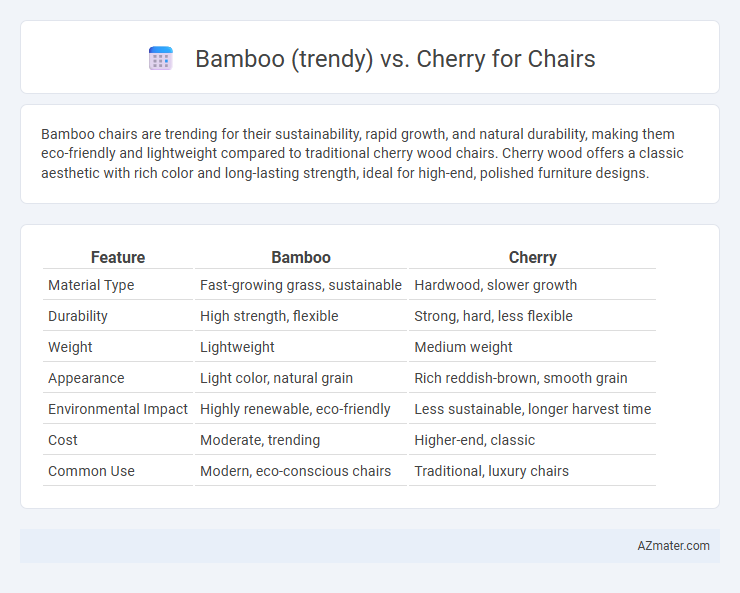Bamboo chairs are trending for their sustainability, rapid growth, and natural durability, making them eco-friendly and lightweight compared to traditional cherry wood chairs. Cherry wood offers a classic aesthetic with rich color and long-lasting strength, ideal for high-end, polished furniture designs.
Table of Comparison
| Feature | Bamboo | Cherry |
|---|---|---|
| Material Type | Fast-growing grass, sustainable | Hardwood, slower growth |
| Durability | High strength, flexible | Strong, hard, less flexible |
| Weight | Lightweight | Medium weight |
| Appearance | Light color, natural grain | Rich reddish-brown, smooth grain |
| Environmental Impact | Highly renewable, eco-friendly | Less sustainable, longer harvest time |
| Cost | Moderate, trending | Higher-end, classic |
| Common Use | Modern, eco-conscious chairs | Traditional, luxury chairs |
Introduction: Bamboo vs Cherry in Chair Trends
Bamboo chairs are gaining popularity due to their sustainability, lightweight durability, and natural resistance to moisture, making them ideal for eco-conscious and modern interior designs. Cherry wood chairs offer timeless elegance with a rich, warm hue and exceptional hardness, appealing to those who value traditional craftsmanship and long-lasting furniture. Current trends show a shift towards bamboo for its environmental benefits and versatility, while cherry remains favored for classic, high-end aesthetics in chair design.
Sustainability: Bamboo and Cherry Compared
Bamboo offers superior sustainability for chairs due to its rapid growth rate, reaching maturity in 3-5 years, and its ability to regenerate without replanting, which drastically reduces deforestation compared to cherry wood that takes 15-30 years to mature. Bamboo's carbon sequestration capabilities and minimal pesticide requirements contribute to its eco-friendly profile, whereas cherry harvesting involves slower replenishment and greater environmental impact. Choosing bamboo enhances sustainable furniture production by supporting renewable resource cycles and lowering carbon footprints relative to traditional cherry wood chairs.
Aesthetics: Visual Appeal of Bamboo vs Cherry Chairs
Bamboo chairs offer a distinctive aesthetic characterized by their light, natural grain and smooth, uniform texture, creating a modern and eco-friendly appeal. Cherry chairs boast rich, warm reddish tones with a smooth finish that deepens over time, exuding a classic and elegant look. The visual appeal of bamboo emphasizes sustainability and simplicity, while cherry chairs highlight timeless sophistication and durability in furniture design.
Durability: Strength and Longevity Factors
Bamboo chairs exhibit exceptional durability due to their high tensile strength and rapid growth cycle, making them both strong and sustainable. Cherry wood offers superior longevity through its dense grain and resistance to wear, developing a rich patina over time that enhances its aesthetic appeal. While bamboo provides lightweight resilience ideal for casual use, cherry chairs are preferred for long-term investment due to their sturdy construction and enduring structural integrity.
Cost Analysis: Bamboo vs Cherry Chair Pricing
Bamboo chairs typically cost 20-30% less than cherry wood chairs due to faster growth rates and sustainable harvesting practices, making bamboo a cost-effective material for furniture manufacturers. Cherry chairs, valued for their rich color and durability, command higher prices averaging 25-50% above bamboo counterparts, reflecting the wood's denser grain and more labor-intensive processing. When evaluating chair pricing, bamboo offers affordability and environmental benefits, while cherry wood chairs present a premium look and long-term investment value.
Comfort and Ergonomics: Material Impact
Bamboo chairs offer exceptional flexibility and natural shock absorption, enhancing comfort through ergonomic support that adapts to body contours. Cherry wood, being denser and sturdier, provides a firm seating experience with precise shaping that supports posture but may feel less forgiving during prolonged use. The material's impact on comfort lies in bamboo's lightweight resilience promoting dynamic seating, whereas cherry wood emphasizes structural integrity for traditional ergonomic stability.
Maintenance and Care: Cleaning Bamboo vs Cherry
Bamboo chairs require regular dusting and wiping with a damp cloth to prevent moisture damage, while avoiding harsh chemicals that can degrade the natural fibers. Cherry wood chairs benefit from periodic polishing with a wood-specific cleaner to maintain their rich color and protect against scratches and stains. Both materials need protection from excessive humidity and direct sunlight to preserve their structural integrity and aesthetic appeal.
Environmental Impact: Bamboo vs Cherry Wood
Bamboo chairs offer superior environmental benefits due to bamboo's rapid growth rate and high carbon sequestration capabilities, making it a highly renewable resource. In contrast, cherry wood comes from slower-growing hardwood trees, resulting in less sustainable harvesting practices and higher environmental impact through deforestation. Choosing bamboo over cherry wood significantly reduces the carbon footprint associated with chair production and supports more eco-friendly furniture options.
Popular Design Styles: Bamboo vs Cherry Chairs
Bamboo chairs feature a modern, eco-friendly aesthetic popular in minimalist and tropical design styles, often showcasing natural textures and sustainability appeal. Cherry chairs are favored in traditional, classic, and colonial interiors for their rich, warm tones and fine grain, adding elegance and durability. Both materials complement diverse decor preferences, with bamboo aligning with casual, contemporary themes and cherry suited for formal, timeless settings.
Buyer Considerations: Choosing Between Bamboo and Cherry
Bamboo chairs offer eco-friendly sustainability and lightweight durability, making them ideal for buyers prioritizing environmental impact and mobility. Cherry wood chairs provide classic aesthetics and long-lasting strength, appealing to those seeking traditional elegance and robust furniture. Buyers should weigh factors like durability, style preference, maintenance needs, and budget when selecting between bamboo's modern appeal and cherry's timeless craftsmanship.

Infographic: Bamboo (trend) vs Cherry for Chair
 azmater.com
azmater.com